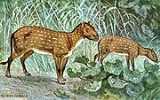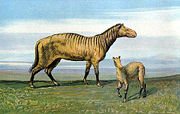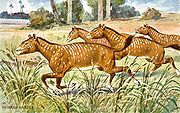
Equidae
Encyclopedia
Equidae is the taxonomic
family
of horse
s and related animals, including the extant horse
s, donkey
s, and zebra
s, and many other species
known only from fossil
s. All extant species are in the genus
Equus
. Equidae belongs to the order Perissodactyla, which includes the extant tapir
s and rhinoceros
, and still more fossils.
The term equid refers to any member of this family, including any equine.
s assigned to Equidae date from the early Eocene
, 54 million years ago. They formerly were assigned to the genus Hyracotherium
(sometimes known as Eohippus), but the type species
of that genus now is regarded to be not a member of this family (see Hyracotherium
). These early Equidae were fox-sized animals with three toes on the hind feet, and four on the front feet. They were herbivorous browsers on relatively soft plants, and already adapted for running. The complexity of their brains suggest that they already were alert and intelligent animals. Later species reduced the number of toes, and developed teeth more suited for grinding up grasses and other tough plant food.
The family became relatively diverse during the Miocene
, with many new species appearing. By this time, equids were more truly horse-like, having developed the typical body shape of the modern animals. Many of these species bore the main weight of their bodies on their central, third, toe, with the others becoming reduced, and barely touching the ground, if at all. The sole surviving genus, Equus, had evolved by the early Pleistocene
, and spread rapidly through the world.






Taxonomy
Taxonomy is the science of identifying and naming species, and arranging them into a classification. The field of taxonomy, sometimes referred to as "biological taxonomy", revolves around the description and use of taxonomic units, known as taxa...
family
Family (biology)
In biological classification, family is* a taxonomic rank. Other well-known ranks are life, domain, kingdom, phylum, class, order, genus, and species, with family fitting between order and genus. As for the other well-known ranks, there is the option of an immediately lower rank, indicated by the...
of horse
Horse
The horse is one of two extant subspecies of Equus ferus, or the wild horse. It is a single-hooved mammal belonging to the taxonomic family Equidae. The horse has evolved over the past 45 to 55 million years from a small multi-toed creature into the large, single-toed animal of today...
s and related animals, including the extant horse
Horse
The horse is one of two extant subspecies of Equus ferus, or the wild horse. It is a single-hooved mammal belonging to the taxonomic family Equidae. The horse has evolved over the past 45 to 55 million years from a small multi-toed creature into the large, single-toed animal of today...
s, donkey
Donkey
The donkey or ass, Equus africanus asinus, is a domesticated member of the Equidae or horse family. The wild ancestor of the donkey is the African Wild Ass, E...
s, and zebra
Zebra
Zebras are several species of African equids united by their distinctive black and white stripes. Their stripes come in different patterns unique to each individual. They are generally social animals that live in small harems to large herds...
s, and many other species
Species
In biology, a species is one of the basic units of biological classification and a taxonomic rank. A species is often defined as a group of organisms capable of interbreeding and producing fertile offspring. While in many cases this definition is adequate, more precise or differing measures are...
known only from fossil
Fossil
Fossils are the preserved remains or traces of animals , plants, and other organisms from the remote past...
s. All extant species are in the genus
Genus
In biology, a genus is a low-level taxonomic rank used in the biological classification of living and fossil organisms, which is an example of definition by genus and differentia...
Equus
Equus (genus)
Equus is a genus of animals in the family Equidae that includes horses, donkeys, and zebras. Within Equidae, Equus is the only extant genus. Like Equidae more broadly, Equus has numerous extinct species known only from fossils. This article deals primarily with the extant species.The term equine...
. Equidae belongs to the order Perissodactyla, which includes the extant tapir
Tapir
A Tapir is a large browsing mammal, similar in shape to a pig, with a short, prehensile snout. Tapirs inhabit jungle and forest regions of South America, Central America, and Southeast Asia. There are four species of Tapirs: the Brazilian Tapir, the Malayan Tapir, Baird's Tapir and the Mountain...
s and rhinoceros
Rhinoceros
Rhinoceros , also known as rhino, is a group of five extant species of odd-toed ungulates in the family Rhinocerotidae. Two of these species are native to Africa and three to southern Asia....
, and still more fossils.
The term equid refers to any member of this family, including any equine.
Evolution
The oldest known fossilFossil
Fossils are the preserved remains or traces of animals , plants, and other organisms from the remote past...
s assigned to Equidae date from the early Eocene
Eocene
The Eocene Epoch, lasting from about 56 to 34 million years ago , is a major division of the geologic timescale and the second epoch of the Paleogene Period in the Cenozoic Era. The Eocene spans the time from the end of the Palaeocene Epoch to the beginning of the Oligocene Epoch. The start of the...
, 54 million years ago. They formerly were assigned to the genus Hyracotherium
Hyracotherium
Hyracotherium , also known as Eohippus or the dawn horse, is an extinct genus of very small perissodactyl ungulates that lived in the woodlands of the northern hemisphere, with species ranging throughout Asia, Europe, and North America during the early Tertiary Period and the early to mid Eocene...
(sometimes known as Eohippus), but the type species
Type species
In biological nomenclature, a type species is both a concept and a practical system which is used in the classification and nomenclature of animals and plants. The value of a "type species" lies in the fact that it makes clear what is meant by a particular genus name. A type species is the species...
of that genus now is regarded to be not a member of this family (see Hyracotherium
Hyracotherium
Hyracotherium , also known as Eohippus or the dawn horse, is an extinct genus of very small perissodactyl ungulates that lived in the woodlands of the northern hemisphere, with species ranging throughout Asia, Europe, and North America during the early Tertiary Period and the early to mid Eocene...
). These early Equidae were fox-sized animals with three toes on the hind feet, and four on the front feet. They were herbivorous browsers on relatively soft plants, and already adapted for running. The complexity of their brains suggest that they already were alert and intelligent animals. Later species reduced the number of toes, and developed teeth more suited for grinding up grasses and other tough plant food.
The family became relatively diverse during the Miocene
Miocene
The Miocene is a geological epoch of the Neogene Period and extends from about . The Miocene was named by Sir Charles Lyell. Its name comes from the Greek words and and means "less recent" because it has 18% fewer modern sea invertebrates than the Pliocene. The Miocene follows the Oligocene...
, with many new species appearing. By this time, equids were more truly horse-like, having developed the typical body shape of the modern animals. Many of these species bore the main weight of their bodies on their central, third, toe, with the others becoming reduced, and barely touching the ground, if at all. The sole surviving genus, Equus, had evolved by the early Pleistocene
Pleistocene
The Pleistocene is the epoch from 2,588,000 to 11,700 years BP that spans the world's recent period of repeated glaciations. The name pleistocene is derived from the Greek and ....
, and spread rapidly through the world.
Classification






- Order Perissodactyla (In addition to Equidae, Perissodactyla includes four species of tapirTapirA Tapir is a large browsing mammal, similar in shape to a pig, with a short, prehensile snout. Tapirs inhabit jungle and forest regions of South America, Central America, and Southeast Asia. There are four species of Tapirs: the Brazilian Tapir, the Malayan Tapir, Baird's Tapir and the Mountain...
in a single genusGenusIn biology, a genus is a low-level taxonomic rank used in the biological classification of living and fossil organisms, which is an example of definition by genus and differentia...
, as well as five living species (belonging to four genera) of rhinocerosRhinocerosRhinoceros , also known as rhino, is a group of five extant species of odd-toed ungulates in the family Rhinocerotidae. Two of these species are native to Africa and three to southern Asia....
.) † indicates extinctExtinctionIn biology and ecology, extinction is the end of an organism or of a group of organisms , normally a species. The moment of extinction is generally considered to be the death of the last individual of the species, although the capacity to breed and recover may have been lost before this point...
taxa.- Family Equidae
- Subfamily †Hyracotheriinae
- Genus †EpihippusEpihippusEpihippus is an extinct genus of the modern horse family Equidae, that lived in the Eocene, from 46 to 38 million years ago.Epihippus is believed to have evolved from Orohippus , which continued the evolutionary trend of increasingly efficient grinding teeth. Epihippus had five grinding,...
- Genus †HaplohippusHaplohippusHaplohippus is an extinct genus of the modern horse family Equidae, that lived in the Eocene, from 42 to 38 million years ago. Fossil remains of Haplohippus have been found in the Clarno Formation, part of the John Day Fossil Beds National Monument. While Haplohippus is quite similar to Orohippus,...
- Genus †Heptaconodon
- Genus †HyracotheriumHyracotheriumHyracotherium , also known as Eohippus or the dawn horse, is an extinct genus of very small perissodactyl ungulates that lived in the woodlands of the northern hemisphere, with species ranging throughout Asia, Europe, and North America during the early Tertiary Period and the early to mid Eocene...
(possibly paraphyleticParaphylyA group of taxa is said to be paraphyletic if the group consists of all the descendants of a hypothetical closest common ancestor minus one or more monophyletic groups of descendants...
with some species belonging to the family †PalaeotheriidaePalaeotheriidaePalaeotheres are an extinct group of herbivorous mammals related to tapirs and rhinoceros, and probably ancestral to horses. They ranged across Europe and Asia during the Eocene through Oligocene 55—28 Ma, existing for approximately ....
) - Genus †OrohippusOrohippusOrohippus is an extinct ancestor of the modern horse that lived in the Eocene .thumb|left|Restoration...
- Genus †Xenicohippus
- Genus †Epihippus
- Subfamily †AnchitheriinaeAnchitheriinaeThe Anchitheriinae are an extinct subfamily of the Perissodactyla family Equidae, the same family which includes modern horses, zebras and donkeys. This subfamily is more primitive then the living members of the family. The group first appeared with Mesohippus in north America during the middle...
- Genus †AnchitheriumAnchitheriumAnchitherium was a fossil horse with a three-toed hoof.Anchitherium was a browsing horse that originated in the early Miocene of North America and subsequently dispersed to Europe and Asia, where it gave rise to the larger bodied genus Sinohippus...
- Genus †ArchaeohippusArchaeohippusArchaeohippus is an extinct three toed member of the family Equidae known from fossils of Late Oligocene to early Miocene age. The genus is noted for several distinct skeletal features. The skull possesses deeply pocketed fossa in a notably long preorbital region. The genus is considered an...
- Genus †Desmatippus
- Genus †HypohippusHypohippusHypohippus is an extinct genus of three-toed Horse, which lived 17 - 11 million years ago. It was the size of a pony, and fossils of it have been found in Nebraska, Colorado, and Montana....
- Genus †Kalobatippus
- Genus †MegahippusMegahippusMegahippus is an extinct equid genus belonging to the subfamily Anchitheriinae. As with other members of this subfamily, Megahippus is more primitive than the living horses. Fossil remains of Megahippus have been found across the U.S., from Montana to Florida.-References:* *...
- Genus †MesohippusMesohippusMesohippus is an extinct genus of early horse. It lived some 40 to 30 million years ago from the late Eocene to the mid-Oligocene...
- Genus †MiohippusMiohippusMiohippus was a genus of prehistoric horse existing longer than most Equidae. Miohippus lived in what is now North America during the Oligocene approximately 32-25 million years ago. While descending genera of this species lived during the Miocene period, the Miohippus was a horse of the Oligocene...
- Genus †ParahippusParahippusParahippus is an extinct relative of the modern horse, very similar to Miohippus, but slightly larger, at around tall, at the withers....
- Genus †Sinohippus
- Genus †Anchitherium
- Subfamily EquinaeEquinaeEquinae is a subfamily of the family Equidae, which lived worldwide from the Hemingfordian stage of the Early Miocene to present and in existence for approximately .-Taxonomy:...
- Genus †MerychippusMerychippusMerychippus is an extinct proto-horse of the family Equidae that was endemic to North America during the Miocene from 20.43—10.3 Ma living for approximately .It had three toes on each foot and is the first horse known to have grazed...
- Genus †ScaphohippusScaphohippusScaphohippus is an extinct Miocene genus of equine, with two known species, known from fossils found in California, New Mexico, Montana, and Nebraska.-History:...
- Tribe †Hipparionini
- Genus †Eurygnathohippus
- Genus †HipparionHipparionHipparion is an extinct genus of horse living in North America, Asia, Europe, and Africa during the Miocene through Pleistocene ~23 Mya—781,000 years ago, existing for...
- Genus †HippotheriumHippotheriumHippotherium is an extinct genus of horse endemic to North America, to Asia, Europe, and Africa during the Miocene through Pliocene ~13.65—3.3 Mya, existing for .- Taxonomy :...
- Genus †NannippusNannippusNannippus is an extinct genus of horse endemic to North America during the Miocene through Pliocene, ~13.3—3.3 Ma, living approximately .Nannippus lived as far south as Central Mexico to as far north as Canada , to California in the west, North Carolina and Florida Nannippus is an extinct genus...
- Genus †Neohipparion
- Genus †Pseudhipparion
- Tribe EquiniEquiniEquini is a tribe of herbivorous mammals of the subfamily Equinae, family Equidae, which lived worldwide from the Hemingfordian stage of the Early Miocene to present and in existence for approximately .-Taxonomy:...
- Genus †AstrohippusAstrohippusAstrohippus is an extinct member of the Equidae tribe Equini, the same tribe that contains the only living equid genus, Equus. Fossil remains have been found in the central United States, Florida, and the Mexican states of Chihuahua, Jalisco, and Guanajuato...
- Genus †CalippusCalippusCalippus may refer to:* Calippus of Syracuse, a student of Plato and Syracusean tyrant.* Callippus, a Greek astronomer and mathematician.* Calippus , a small lunar crater.* Calippus, an extinct relation of the modern horse....
- Genus †DinohippusDinohippusDinohippus , is an extinct herbivorous mammal belonging to the tribe Equini, subfamily Equinae, which was endemic to North America from the late Hemphillian stage of the Miocene through the Zanclean stage of the Pliocene and in existence for approximately .-Taxonomy:Dinohippus was named by Quinn...
- Genus EquusEquus (genus)Equus is a genus of animals in the family Equidae that includes horses, donkeys, and zebras. Within Equidae, Equus is the only extant genus. Like Equidae more broadly, Equus has numerous extinct species known only from fossils. This article deals primarily with the extant species.The term equine...
(22 species, 7 extant) - Genus †HippidionHippidionHippidion was a Welsh pony-sized horse that lived in South America during the Pleistocene epoch, between two million and 10,000 years ago....
- Genus †Onohippidium
- Genus †PliohippusPliohippusPliohippus is an extinct genus of Equidae, the "horse family". Pliohippus arose in the middle Miocene, around 12 million years ago, probably from Calippus. It was similar in appearance to Equus, but had two long extra toes on both sides of the hoof, externally barely visible as callused stubs...
- Genus †ProtohippusProtohippusProtohippus is an extinct genus of horse....
- Genus †Astrohippus
- Genus †Merychippus
- Genus †Acritohippus
- Genus †Eurohippus
- Genus †Heteropliohippus
- Genus †Parapliohippus
- Genus †Proboscidipparion
- Subfamily †Hyracotheriinae
- Family Equidae

